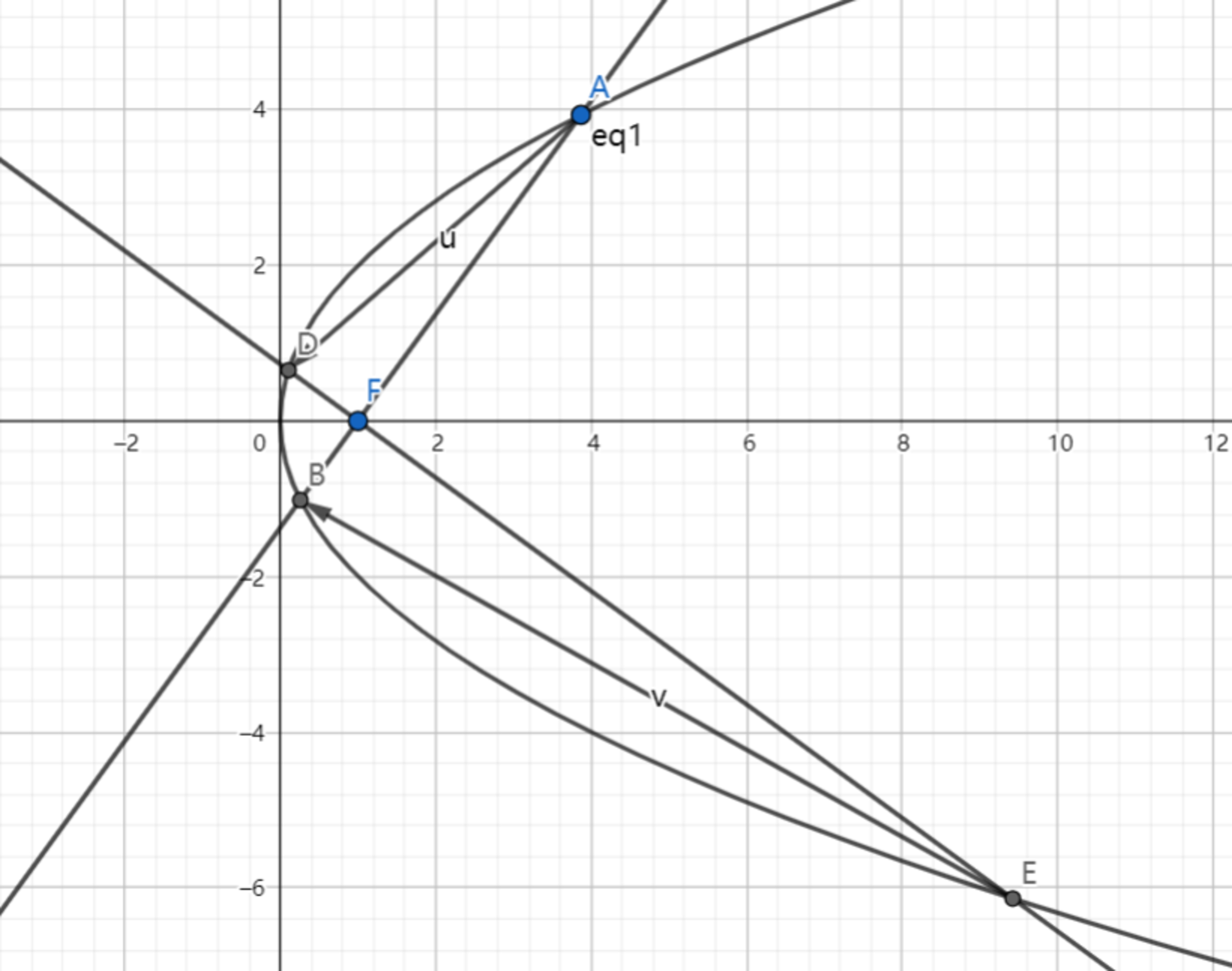SAT1000 - P807

As shown above, parabola C has equation: y 2 = 4 x and its focus is F .
Line l 1 , l 2 both passes through F , l 1 intersects with C at A , B , l 2 intersects with C at D , E , l 1 ⊥ l 2 .
Then find the minimum value of A D ⋅ E B .
Let M be the minimum value. Submit ⌊ 1 0 0 0 M ⌋ .
Have a look at my problem set: SAT 1000 problems
The answer is 16000.
This section requires Javascript.
You are seeing this because something didn't load right. We suggest you, (a) try
refreshing the page, (b) enabling javascript if it is disabled on your browser and,
finally, (c)
loading the
non-javascript version of this page
. We're sorry about the hassle.
2 solutions
Let the position coordinates of A , B , D , E be ( t 2 , 2 t ) , ( t 2 1 , − t 2 ) , ( t 1 2 , 2 t 1 ) , ( t 1 2 1 , − t 1 2 ) respectively. Then
A D = ( t 1 − t ) ( i ^ ( t 1 + t ) + 2 j ^ )
E B = ( t 1 − t 1 1 ) ( i ^ ( t 1 1 + t 1 ) − 2 j ^ )
⟹ A D . E B = ( t t 1 ( t 1 − t ) 2 ) 2
Now, t 1 = t + 1 t − 1 , or − t − 1 t + 1 . (since A B and D E are mutually perpendicular).
So A D . E B = ( t 3 − t t 4 + 2 t 2 + 1 ) 2 .
This will be minimum when t 6 − 5 t 4 − 5 t 2 + 1 = 0 , the minimum value being 4 2 = 1 6 . Therefore the required answer is 1 6 0 0 0 .
Let the slope of A B be m . Since it goes through the focus at F ( 1 , 0 ) , the line A B has the equation y = m ( x − 1 ) , and since A B is perpendicular to D E at F , the line D E has the equation y = − m 1 ( x − 1 ) .
The intersection points of these lines with the parabola y 2 = 4 x are A ( ( m 1 + m 2 + 1 ) 2 , 2 ( m 1 + m 2 + 1 ) ) , B ( ( m 1 − m 2 + 1 ) 2 , 2 ( m 1 − m 2 + 1 ) ) , D ( ( m − m 2 + 1 ) 2 , − 2 ( m − m 2 + 1 ) ) , and E ( ( m + m 2 + 1 ) 2 , − 2 ( m + m 2 + 1 ) ) .
A D ⋅ E B = ( D x − A x ) ( B x − E x ) + ( D y − A y ) ( B y − E y ) , which simplifies to A D ⋅ E B = m 2 4 ( m 2 + 1 ) 2 .
By the AM-GM inequality, the terms m 2 and 1 have the relation 2 m 2 + 1 ≥ m 2 ⋅ 1 , which can be rearranged to m 2 4 ( m 2 + 1 ) 2 ≥ 1 6 or A D ⋅ E B ≥ 1 6 .
Therefore, the minimum value of A D ⋅ E B is M = 1 6 , and ⌊ 1 0 0 0 M ⌋ = 1 6 0 0 0 .